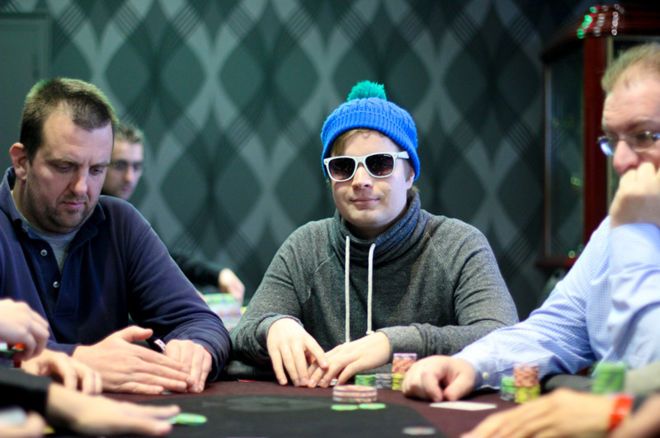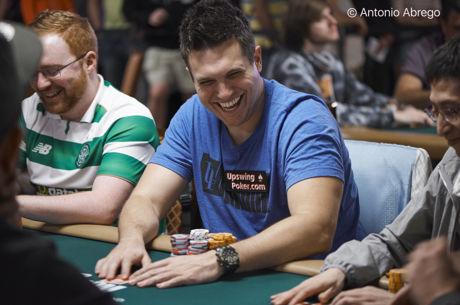Why You Should Play Aggressively on the Final Table Bubble

Table Of Contents
An article by Miikka Anttonen (lead photo) and Mike Brady.
You��ve spent several hours (or possibly even days) playing in a tournament, and the finish line is finally within sight.
There are just ten players left. One bust-out away from the final table. And you really, really don��t want to be that final table bubble boy walking away with 10th place money.
But, believe it or not, this is oftentimes a situation that calls for taking risks and ramping up the aggression, depending on your stack size, opponents, and the tournament��s structure.
In this article, I��ll share advice playing final table bubbles so you know when you play aggressively and when to sit back and play tight.
Don��t Treat the Final Table Bubble Like a Money Bubble
When you��re close to the money bubble, it��s usually pretty irresponsible to take big risks. Even if you feel the urge to punish a big stack who is playing every hand, it��s probably best to ignore it.
For example, suppose you��re on the button with Q?J? and a 34,000 chip stack near the money bubble of a tournament. With the blinds at 1,000/2,000, an aggressive big stack raises to 4,000 from the cutoff.
This is a clearly profitable 3-bet shove in terms of chips. If the shove gets through, which it often will, you will add about 9,000 chips to your stack. Is that a nice addition? Sure.
Some percentage of the time, however, your shove will get called and you will bust out just short of the money. This is an absolute disaster considering how unimportant that potential 9,000 chip gain was to your chances of running deep in the tournament.
New scenario now: you��re still in a big tournament with 10 players left. You��re one of the short stacks with 900,000 chips and get dealt A?3? in the big blind. With the blinds at 25,000/50,000, the aggressive chip leader raises to 100,000 on the button.
Unlike the money bubble example, this is a great spot to try to pick up about 175,000 chips with a shove. Adding a few big blinds to your stack at such a key stage of the tournament will notably improve your chances of reaching the top 3. Additionally, busting in 10th isn��t so bad considering you were one of the short stacks, meaning you were likely going to bust in 9th-7th anyway (more on this shortly).
In fact, one of the best spots to win a lot of chips without showdown is the final table bubble. Here��s why:
- The chip leader is typically opening nearly every pot, allowing shorter stacks to re-steal against those opens.
- The short stacks are often scared of busting and trying to ladder up.
- The middle stacks have their hands tied as they��re supposed to wait for the short stacks to bust before taking risks.
Note: If you play live poker, you can improve your skills by getting Upswing Poker��s free guide The 10 Laws of Live Poker. Download now!
3 More Reasons to Play Aggressively on Final Table Bubbles
In case you are still not convinced, here��s 3 more reasons why you should turn up the heat on final table bubbles:
1. You��re playing short-handed
On money bubbles you��re typically playing 8- or 9-handed, but on the final table bubble you never have more than 5 players at your table. This requires you to play more hands since you��ll always be in late position or the blinds.
It��s especially important to loosen up if you��re playing a tournament with a big blind ante. With only 5 players at the table, there would normally only be 5 antes to fight for. When there��s a big blind ante, however, it��s like there are 10 players anteing, but you only have to beat 4!
2. Nobody wants to miss out on the final table
This is especially true in live tournaments and big online events. The longer it has taken for everyone to get to that point in the tournament and the more money there is on the line, the less they want to bust. That��s something to be exploited.
3. The ICM impact of busting actually isn��t that huge
There are obvious exceptions where the difference between getting 10th and 9th is enormous (e.g. the WSOP Main Event), but in the vast majority of tournaments, it really doesn��t matter all that much whether you get 10th, 8th, or 7th.
For example, here are the payouts for a $215 buy-in tournament (the Sunday Warm-up on PokerStars):
| Position | Payout | Position | Payout |
|---|---|---|---|
| 1st | $43,216 | 6th | $8,698 |
| 2nd | $31,361 | 7th | $6,312 |
| 3rd | $22,759 | 8th | $4,580 |
| 4th | $16,516 | 9th | $3,324 |
| 5th | $11,985 | 10th | $2,412 |
The difference between 10th and 9th place is just four and a half buy-ins, but the difference between 10th and 1st is almost 200 buy-ins. It��d be inexcusable to blind down and give up the chance of winning the tournament in order to make a $912 pay jump.
When Tight is Right
The more you find yourself battling on final table bubbles, the more you��ll get used to picking your spots and finding ways to chip up. But no matter how experienced you are, it is still best to tighten up in some scenarios:
- Play tighter when your opponents are playing very aggressively. If your opponents are relentlessly battling each other, it makes sense to sit back and wait for someone to spaz-out.
- Tighten up when making the final table really matters. This is usually in big live tournaments like the WSOP Main Event, where the notoriety and sponsorship potential skyrockets from 10th to 9th.
- Play tighter when the money really matters. If the difference between 10th and 9th place money would greatly impact your life, it is more than reasonable to sacrifice some expected value to lock up the pay jump.
- Tighten up when you��re a medium stack and there is one or more short stacks. You��re very likely to make a bunch of pay jumps without doing anything fancy, so sit back, play tight, and hope the short stacks bust.
One Last Piece of Advice
When you��re the chip leader, you should play very aggressively in small pots because most players will try to stay out of your way. When you play a big pot, however, try to have the goods most of the time. You don��t want to be the guy who spews off a big stack trying to win a few big blinds.
Note: Level-up your live poker skills and mental game with The 10 Laws of Live Poker, a strategy guide from Upswing Poker. Get it for free now!
Sponsor generated content by Upswing Poker (written by Miikka Anttonen and Mike Brady)








